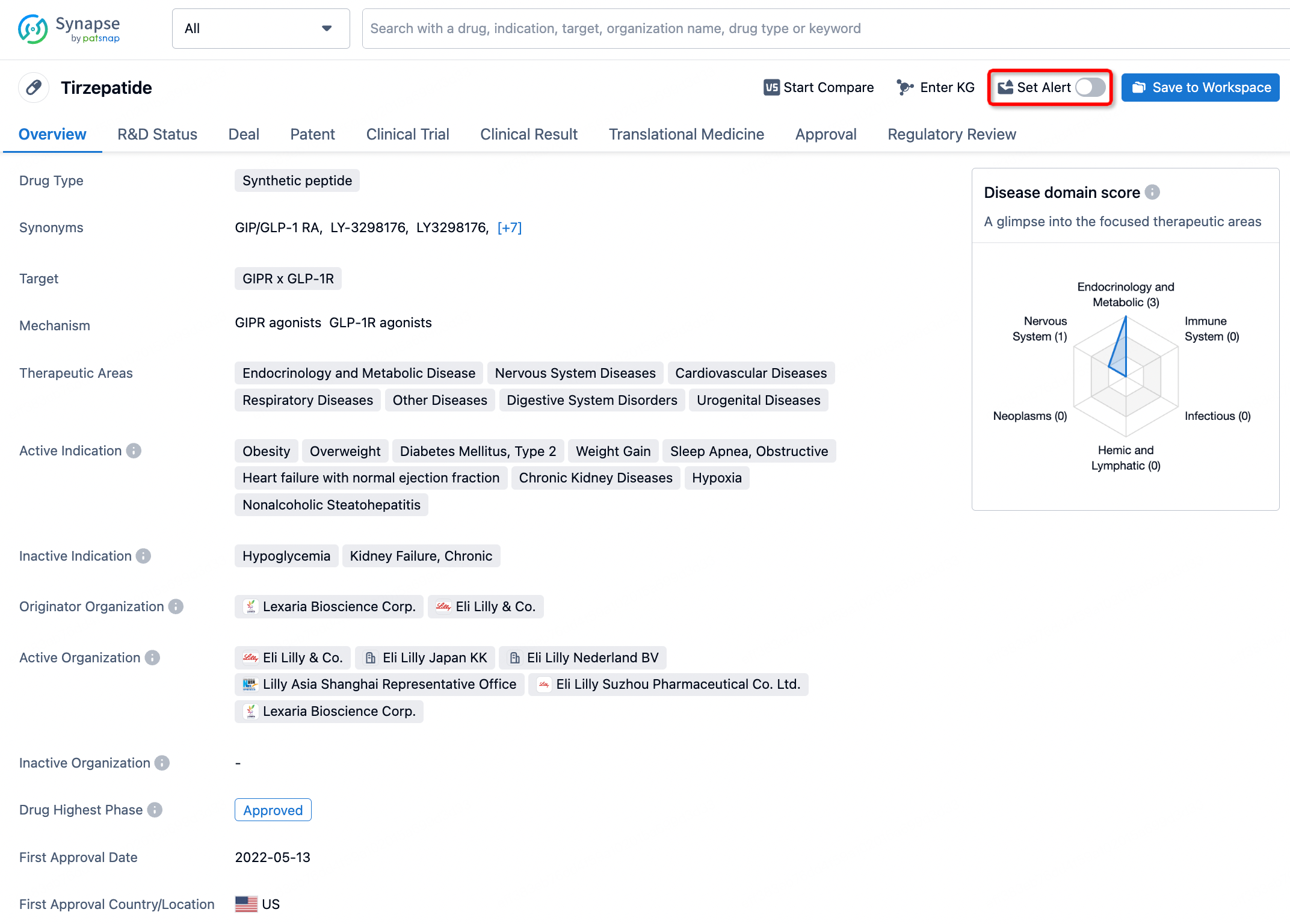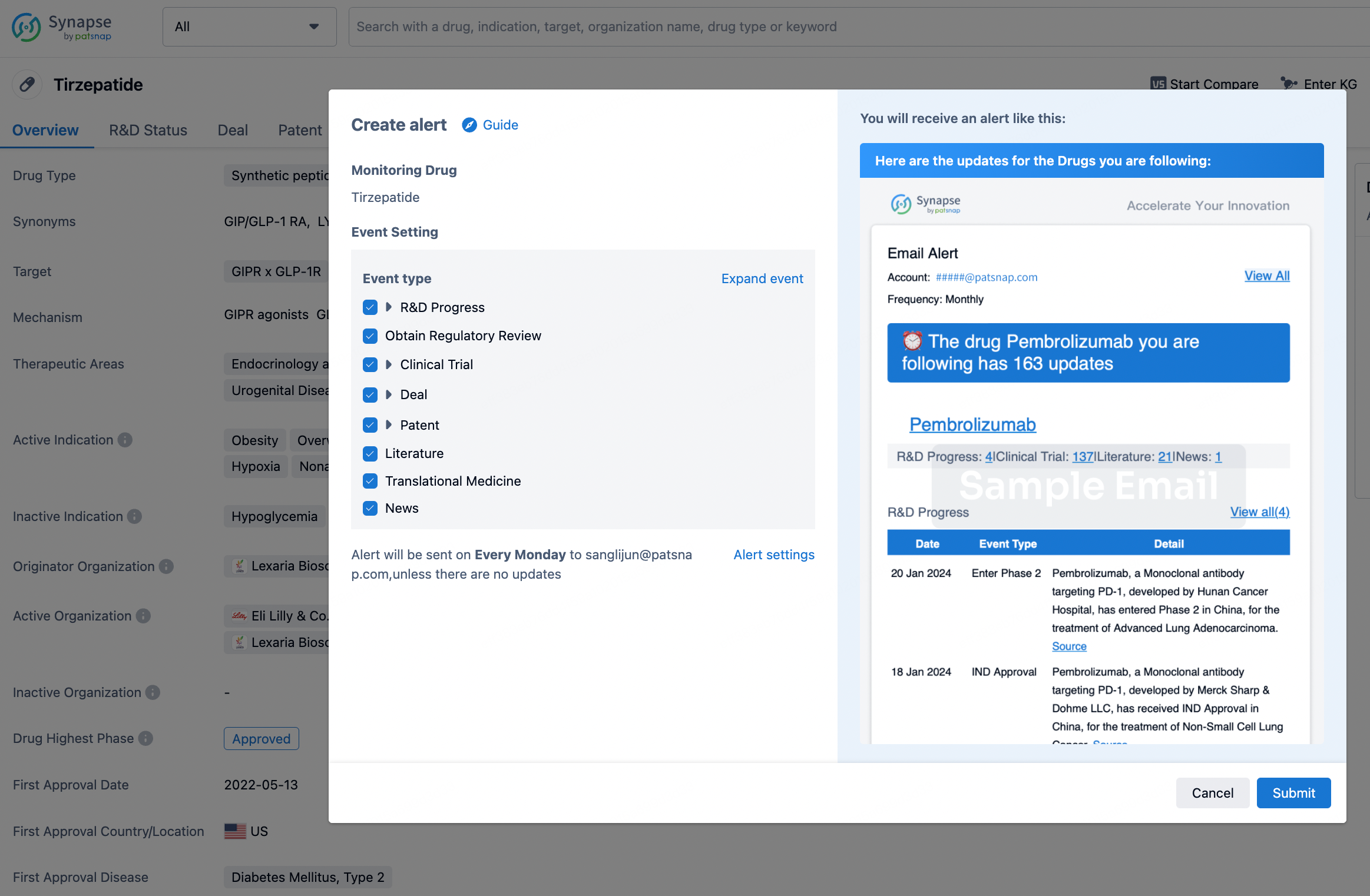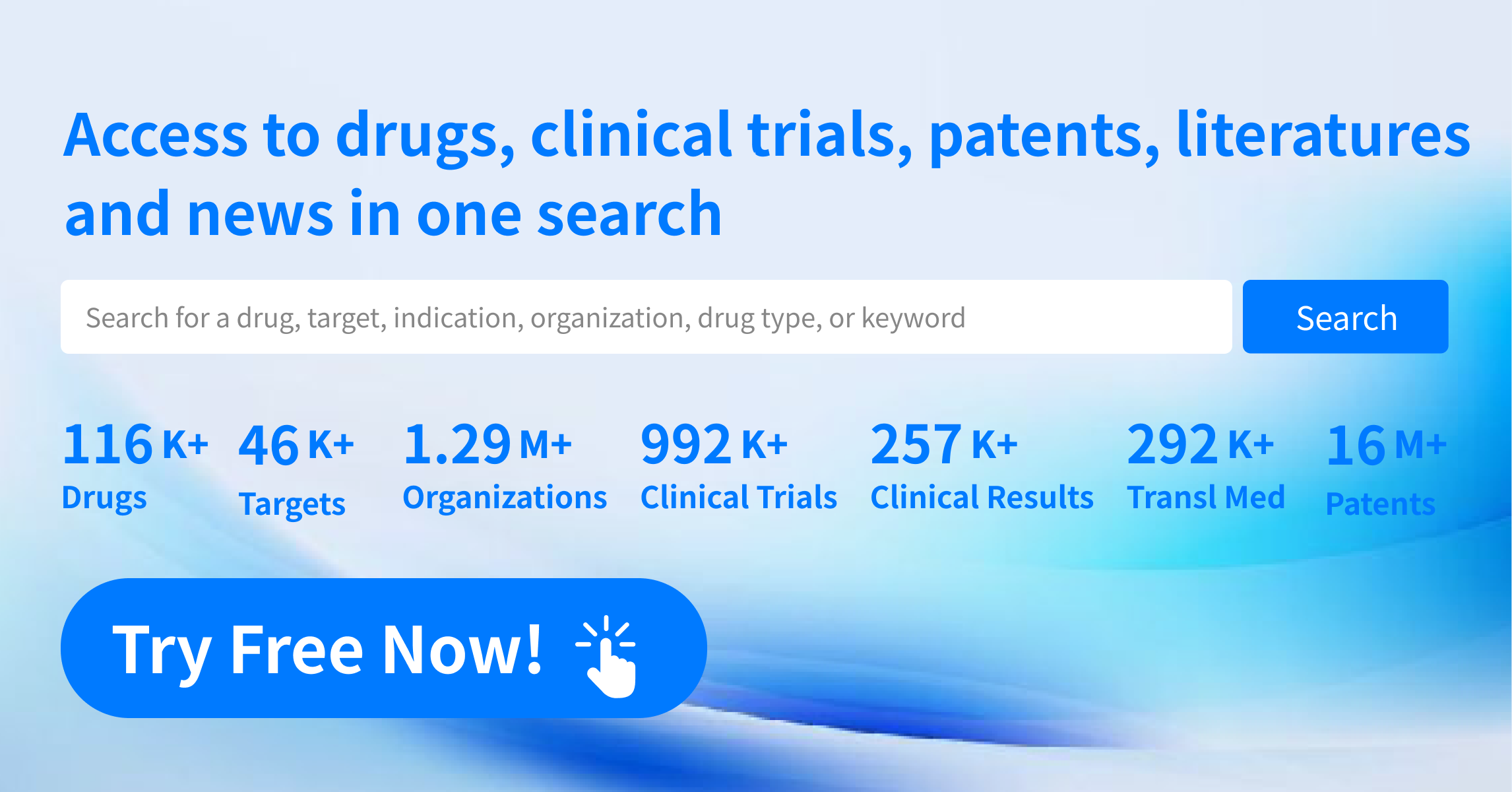Request Demo
What is Beinaglutide used for?
14 June 2024
Introduction to Beinaglutide
Beinaglutide is a promising new drug that has been making waves in the medical community for its potential in managing certain metabolic conditions. Its scientific name might not be a household term yet, but those who follow advancements in diabetes and metabolic disorder treatments have likely heard of it. Beinaglutide is also known by its trade names, which vary depending on the manufacturer and the region where it is marketed. As a type of glucagon-like peptide-1 (GLP-1) receptor agonist, Beinaglutide is part of a class of drugs that have shown significant promise in the treatment of type 2 diabetes mellitus.
Research into Beinaglutide has been spearheaded by various pharmaceutical companies and research institutions, aiming to establish its efficacy and safety. This drug works by mimicking the actions of GLP-1, a hormone that plays a critical role in blood sugar regulation. It's not just limited to blood sugar control; GLP-1 receptor agonists like Beinaglutide are also being explored for their potential in weight management and even cardiovascular health. Clinical trials have been ongoing to explore these facets, and while some results are promising, research is still in the relatively early stages.
Beinaglutide Mechanism of Action
The mechanism of action for Beinaglutide centers around its role as a GLP-1 receptor agonist. GLP-1 is an incretin hormone, which means it is released after eating and stimulates insulin secretion while inhibiting glucagon release. This dual action helps lower blood glucose levels. Beinaglutide binds to the GLP-1 receptors found predominantly in the pancreas, among other tissues. When it binds to these receptors, it triggers a cascade of events that lead to increased insulin secretion from the beta cells of the pancreas and decreased glucagon release from the alpha cells.
Furthermore, Beinaglutide slows gastric emptying, which means that food moves more slowly from the stomach to the small intestine. This slower movement can lead to a feeling of fullness, which may help in weight management—a beneficial side effect for many people with type 2 diabetes, who often struggle with obesity. By taking advantage of these multiple pathways, Beinaglutide offers a comprehensive approach to managing blood sugar levels and potentially aiding in weight reduction.
How to Use Beinaglutide
Beinaglutide is administered through subcutaneous injections, which means it is injected under the skin. The exact dosage and frequency depend on the specific needs of the patient and the prescribing physician's recommendations. Generally, patients are started on a lower dose to minimize potential side effects and then gradually increased to a maintenance dose.
The onset of action for Beinaglutide can vary, but patients might begin to see changes in their blood sugar levels within a few hours after the first dose. However, it may take a few weeks to achieve the full therapeutic effect, as the body's systems adjust to the medication. It is often recommended to administer the injection at the same time each day to maintain consistent blood levels of the drug.
Patients should follow the instructions provided by their healthcare provider meticulously. This includes understanding how to properly prepare and administer the injection, and what to do if a dose is missed. It is also advisable for patients to monitor their blood sugar levels regularly to gauge the drug's effectiveness and report any unusual readings to their healthcare provider.
What is Beinaglutide Side Effects
Like any medication, Beinaglutide comes with a potential for side effects. The most commonly reported side effects are gastrointestinal in nature, including nausea, vomiting, diarrhea, and constipation. These side effects are generally mild to moderate in severity and tend to resolve as the body adjusts to the medication. To minimize these effects, healthcare providers often recommend starting with a lower dose and gradually increasing it.
However, there are some more serious side effects that require immediate medical attention. These include symptoms of pancreatitis, such as severe abdominal pain that may radiate to the back, nausea, and vomiting. If these symptoms occur, it's crucial to stop the medication and seek medical help immediately. Other serious side effects can include allergic reactions, characterized by rash, itching, swelling, severe dizziness, and trouble breathing.
Contraindications for Beinaglutide include a history of severe gastrointestinal disease, such as gastroparesis, and a personal or family history of medullary thyroid carcinoma or multiple endocrine neoplasia syndrome type 2. Additionally, it should be used with caution in patients with a history of pancreatitis.
What Other Drugs Will Affect Beinaglutide
Beinaglutide can interact with other medications, potentially altering its effectiveness or increasing the risk of adverse effects. For instance, it should be used with caution in combination with other medications that affect blood sugar levels, such as insulin or sulfonylureas, due to the increased risk of hypoglycemia. In such cases, the doses of these other medications may need to be adjusted.
Other drugs that slow gastric emptying, such as opioids, may also interact with Beinaglutide, potentially exacerbating gastrointestinal side effects. Additionally, medications that require rapid absorption, such as certain antibiotics or oral contraceptives, may have their absorption delayed due to the slowed gastric emptying caused by Beinaglutide.
Patients should inform their healthcare provider of all medications they are currently taking, including over-the-counter drugs and supplements, to ensure that potential interactions are managed appropriately. Regular monitoring and follow-up appointments are essential to adjust dosages and manage any interactions effectively.
In conclusion, while Beinaglutide offers significant promise for managing type 2 diabetes and potentially aiding in weight management, it is not without its challenges. Understanding its mechanism of action, proper usage, potential side effects, and drug interactions are crucial for maximizing its benefits and minimizing risks. As research continues, we can expect to learn more about this exciting medication and its place in the treatment of metabolic disorders.
Beinaglutide is a promising new drug that has been making waves in the medical community for its potential in managing certain metabolic conditions. Its scientific name might not be a household term yet, but those who follow advancements in diabetes and metabolic disorder treatments have likely heard of it. Beinaglutide is also known by its trade names, which vary depending on the manufacturer and the region where it is marketed. As a type of glucagon-like peptide-1 (GLP-1) receptor agonist, Beinaglutide is part of a class of drugs that have shown significant promise in the treatment of type 2 diabetes mellitus.
Research into Beinaglutide has been spearheaded by various pharmaceutical companies and research institutions, aiming to establish its efficacy and safety. This drug works by mimicking the actions of GLP-1, a hormone that plays a critical role in blood sugar regulation. It's not just limited to blood sugar control; GLP-1 receptor agonists like Beinaglutide are also being explored for their potential in weight management and even cardiovascular health. Clinical trials have been ongoing to explore these facets, and while some results are promising, research is still in the relatively early stages.
Beinaglutide Mechanism of Action
The mechanism of action for Beinaglutide centers around its role as a GLP-1 receptor agonist. GLP-1 is an incretin hormone, which means it is released after eating and stimulates insulin secretion while inhibiting glucagon release. This dual action helps lower blood glucose levels. Beinaglutide binds to the GLP-1 receptors found predominantly in the pancreas, among other tissues. When it binds to these receptors, it triggers a cascade of events that lead to increased insulin secretion from the beta cells of the pancreas and decreased glucagon release from the alpha cells.
Furthermore, Beinaglutide slows gastric emptying, which means that food moves more slowly from the stomach to the small intestine. This slower movement can lead to a feeling of fullness, which may help in weight management—a beneficial side effect for many people with type 2 diabetes, who often struggle with obesity. By taking advantage of these multiple pathways, Beinaglutide offers a comprehensive approach to managing blood sugar levels and potentially aiding in weight reduction.
How to Use Beinaglutide
Beinaglutide is administered through subcutaneous injections, which means it is injected under the skin. The exact dosage and frequency depend on the specific needs of the patient and the prescribing physician's recommendations. Generally, patients are started on a lower dose to minimize potential side effects and then gradually increased to a maintenance dose.
The onset of action for Beinaglutide can vary, but patients might begin to see changes in their blood sugar levels within a few hours after the first dose. However, it may take a few weeks to achieve the full therapeutic effect, as the body's systems adjust to the medication. It is often recommended to administer the injection at the same time each day to maintain consistent blood levels of the drug.
Patients should follow the instructions provided by their healthcare provider meticulously. This includes understanding how to properly prepare and administer the injection, and what to do if a dose is missed. It is also advisable for patients to monitor their blood sugar levels regularly to gauge the drug's effectiveness and report any unusual readings to their healthcare provider.
What is Beinaglutide Side Effects
Like any medication, Beinaglutide comes with a potential for side effects. The most commonly reported side effects are gastrointestinal in nature, including nausea, vomiting, diarrhea, and constipation. These side effects are generally mild to moderate in severity and tend to resolve as the body adjusts to the medication. To minimize these effects, healthcare providers often recommend starting with a lower dose and gradually increasing it.
However, there are some more serious side effects that require immediate medical attention. These include symptoms of pancreatitis, such as severe abdominal pain that may radiate to the back, nausea, and vomiting. If these symptoms occur, it's crucial to stop the medication and seek medical help immediately. Other serious side effects can include allergic reactions, characterized by rash, itching, swelling, severe dizziness, and trouble breathing.
Contraindications for Beinaglutide include a history of severe gastrointestinal disease, such as gastroparesis, and a personal or family history of medullary thyroid carcinoma or multiple endocrine neoplasia syndrome type 2. Additionally, it should be used with caution in patients with a history of pancreatitis.
What Other Drugs Will Affect Beinaglutide
Beinaglutide can interact with other medications, potentially altering its effectiveness or increasing the risk of adverse effects. For instance, it should be used with caution in combination with other medications that affect blood sugar levels, such as insulin or sulfonylureas, due to the increased risk of hypoglycemia. In such cases, the doses of these other medications may need to be adjusted.
Other drugs that slow gastric emptying, such as opioids, may also interact with Beinaglutide, potentially exacerbating gastrointestinal side effects. Additionally, medications that require rapid absorption, such as certain antibiotics or oral contraceptives, may have their absorption delayed due to the slowed gastric emptying caused by Beinaglutide.
Patients should inform their healthcare provider of all medications they are currently taking, including over-the-counter drugs and supplements, to ensure that potential interactions are managed appropriately. Regular monitoring and follow-up appointments are essential to adjust dosages and manage any interactions effectively.
In conclusion, while Beinaglutide offers significant promise for managing type 2 diabetes and potentially aiding in weight management, it is not without its challenges. Understanding its mechanism of action, proper usage, potential side effects, and drug interactions are crucial for maximizing its benefits and minimizing risks. As research continues, we can expect to learn more about this exciting medication and its place in the treatment of metabolic disorders.
How to obtain the latest development progress of all drugs?
In the Synapse database, you can stay updated on the latest research and development advances of all drugs. This service is accessible anytime and anywhere, with updates available daily or weekly. Use the "Set Alert" function to stay informed. Click on the image below to embark on a brand new journey of drug discovery!
AI Agents Built for Biopharma Breakthroughs
Accelerate discovery. Empower decisions. Transform outcomes.
Get started for free today!
Accelerate Strategic R&D decision making with Synapse, PatSnap’s AI-powered Connected Innovation Intelligence Platform Built for Life Sciences Professionals.
Start your data trial now!
Synapse data is also accessible to external entities via APIs or data packages. Empower better decisions with the latest in pharmaceutical intelligence.


